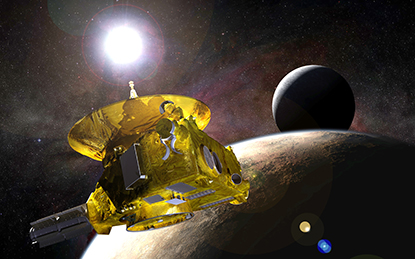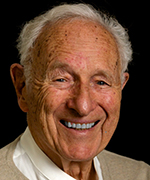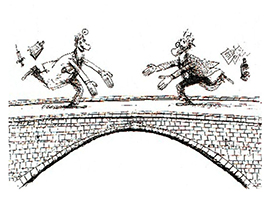Demystifying Medicine
NIH Course Bridges the Gap Between Basic Research and Clinical Medicine
What do you get when you combine a clinician, a Ph.D. scientist, and a patient? A course called “Demystifying Medicine” that bridges the gap between basic research and clinical medicine and covers a range of topics from genetics to infectious disease to the effect of spaceflight on humans.

JOHNS HOPKINS UNIVERSITY APPLIED PHYSICS LABORATORY/SOUTHWEST RESEARCH INSTITUTE
One of the Demystifying Medicine sessions featured a space scientist who talked about the importance of biomedical research that addresses the medical needs of future space travelers. Shown: Artist’s concept of the New Horizons spacecraft encountering Pluto and its largest moon, Charon, in July 2015. The craft’s miniature cameras, radio science experiment, ultraviolet and infrared spectrometers and space plasma experiments will characterize the global geology and geomorphology of Pluto and Charon, map their surface compositions and temperatures, and examine Pluto’s atmosphere in detail.
The course is the brainchild of Irwin “Win” Arias, who started it at NIH in 2002 after having run a similar course at Tufts University School of Medicine (Boston) for eight years. Arias was a professor and chair of cellular and molecular physiology at Tufts before coming to NIH in 2001 for what was to have been a nine-month position as a Fogarty Scholar. He has been at NIH ever since and is now a senior scientist emeritus in the National Institute of Child Health and Human Development, an assistant to the Deputy Director for Intramural Research, and director of the NIH’s “Demystifying Medicine” course.
Arias, who has an M.D. degree and considers himself a physician-scientist, has done pioneering research in the pathobiology of acquired and inherited liver disease that has led to a better understanding of how the liver functions. He discovered the mechanisms of inheritable jaundice; that ATP-binding cassette transporters (ABC transporters) mediate bile transport; and that AMP kinase and liver kinase-B1 regulate hepatocyte polarization, mitochondrial fusion, ATP production, and bile transporters.
Physician-scientists combine investigator, clinician, and teacher skills and were a flourishing breed from World War II through the 1970s. But as basic-science research became more complex and research and training budgets began shrinking, medical schools could no longer incorporate basic-science training into the curriculum, and consequently M.D. students had little exposure to research. To make matters worse, Ph.D. programs in the biomedical sciences did not provide training in pathobiology, so graduates of those programs had little understanding of clinical disease, advances in diagnosis and therapy, and the major unsolved clinical problems that challenge basic research.
Arias created the “Demystifying Medicine” course as one way to bridge the ever-increasing gap between advances in basic biology and their application to human disease.

Irwin Arias who founded and runs the Demystifying Medicine course at NIH.
“The whole idea of training Ph.D.’s about disease is so they can communicate with clinicians,” said Arias. It’s about “building bridges” between the basic scientists and the clinicians. And bringing in patients “puts a human face on the disease.”
The 20-week course, made up of weekly two-hour classes and held from January through May each year, reaches national and international audiences. About 900 Ph.D. and M.D. students, fellows, and staff register annually; each week, an average of 85 people attend classes in person and about 250 attend via live videocast; and thousands more in the United States and around the world view the archived videocasts later either through the NIH videocast archive or on YouTube. The course has also been replicated at 21 institutions in North America and in 18 foreign countries.
The topics are wide ranging and have included sessions on all types of cancer; emerging and re-emerging infectious diseases; AIDS and human immunodeficiency virus; heart disease; diabetes; obesity; sleep; prions; autoimmune diseases; stem cells; transplantation; all types of dementia and other neurological disorders; aging; hearing loss; agents of potential bioterrorism including smallpox and anthrax; three-dimensional (3-D) and 4-D imaging to study organs and cells; genetic screening; inflammatory diseases; addiction; undiagnosed diseases; precision medicine; the microbiome, and much, much more.
Most of the presenters are NIHers—some are even institute directors such as Anthony Fauci (National Institute of Allergy and Infectious Diseases), who has given talks on Ebola, the Zika virus, and other infectious diseases.
The 2016 session was kicked off by Nobel laureate Eric Kandel (Columbia University, New York) who spoke about “The Age of Insight: The Quest to Understand the Unconscious in Art, Mind, and Brain from Vienna 1900 to the Present.” Kandel, who trained in neurobiology at NIH in the 1950s and in psychiatry at Harvard Medical School (Boston), shared the 2000 Nobel Prize in Physiology or Medicine with Arvid Carlsson and Paul Greengard for discoveries about signal transduction in the nervous system.
Fauci talked about “Ebola, MERS and Likelihood of More Epidemics”; and Eric Green, the director of the National Human Genome Research Institute, talked about “The Future of Medicine: Personalized, Precision, and Other.” The rest of the 2016 season was equally exciting with such topics as the microbiome, aging, trauma, cancer, and the effect of space flight on humans. (See sidebar for 2016 listing.)
As a special treat, you can read this month in the NIH Catalyst about two of the sessions in more detail: "Demysitfying Health Effects of Global War“Global Warming: Effect on Vector Distribution, Disease, and Natural Product Research” and “Robotic Planetary Exploration and Thoughts about Human Spaceflight.”
For more about the course—which is administered by the NIH Clinical Center— including background information about each topic, speakers’ CVs, selected references, and PowerPoint presentations, go to https://demystifyingmedicine.od.nih.gov. You can view past videocasts (dating back to 2003) at https://videocast.nih.gov/PastEvents.asp?c=45.
DEMYSTIFYING MEDICINE 2016

January 5: “The Age of Insight: The Quest to Understand the Unconscious in Portraiture Art, Mind and Brain from Vienna 1900 to the Present” (Eric R. Kandel, Columbia University)
January 12: “Ebola, MERS and Likelihood of More Epidemics” (Anthony Fauci, NIAID); “Evolutionary Dynamics and Zoonotic and Cross-species Transmission of Emerging Viruses” (Vincent Munster, NIAID)
January 19: “The Future of Medicine: Personalized, Precision, and Other” (Eric Green, NHGRI)
February 2: “Where Do Viruses Come from and How Do They Do What They Do?” (John Coffin, NCI and Tufts); “From A to E: 2000 Years of Hepatitis Virus History” (Harvey Alter, CC)
February 9: “The Intestinal Microbiome and Inflammatory Bowel Disease” (Yasmine Belkaid and Warren Strober, NIAID)
February 16: “Atopy: The Common and the Rare Allergies in the Genomic Era“ (Joshua Milner and Pamela Guerrerio, NIAID)
February 23: “Shingles (Herpes Zoster) Revisited” (Jeffrey Cohen and Lesia Dropulic, NIAID)
March 1: “Cell Polarity: Mechanisms and Disease in the Nervous System and Liver” (Juan Bonifacino, NICHD; Irwin Arias, CC and NICHD)
March 8: “Depression: Neuromodulation Meets Super-resolution Cell Biology” (Sarah H. Lisanby, NIMH; Justin Taraska, NHLBI)
March 15: “Non-alcoholic Fatty Liver Disease and Steato-hepatitis (NAFLD/NASH): An ‘Epidemic’ Liver Disease Requiring New Drugs” (Yaron Rotman, NIDDK; Rosanah Kapellar, Nimbus Therapeutics)
March 22: “Progress in Understanding Congenital Heart Disease (the #1 Killer in Birth Defects): Mechanisms and New Technologies” (Gail Pearson and Robert Lederman, NHLBI)
March 29: “The Oral Microbiome Meets Cell Biology and Periodontal Disease” (Niki Moutsopoulos, NIDCR; Robert Palmer, NIDCR; and Alex Valm, NICHD)
April 5: “Multiple Sclerosis: Mechanisms and Imaging the Process” (Daniel Reich and Irene Cortese, NINDS)
April 12: “Global Warming: Effect on Vector Distribution, Disease, and Natural Product Research” (Jonathan Sleeman, U.S. Geological Survey; David Newman, NCI)
April 19: “Trauma in the Modern Age: Injury and Stem Cells” (Paul Pasquina, U.S. Army, Uniformed Services University of the Health Sciences; Ronald McKay, Leiber Institute and Johns Hopkins)
April 26: “Hepatocellular Cancer: Problems and Progress in an Epidemic Disease” (Win Arias, CC and NICHD; Tim Greten, NCI)
May 3: “Cholesterol: Too Much and Too Little Are Bad for Your Health” (Forbes Porter, NICHD; Robert Shamburek, NHLBI)
May 10: “Robotic Planetary Exploration and Thoughts about Human Spaceflight” (Stamatios Krimigis, Johns Hopkins Applied Physics Laboratory)
May 17: How Long Can and Should We Live?” (Luigi Ferruci, NIA); “What Centenarians Teach Us about Aging” (Nir Barzilai, Albert Einstein College of Medicine)
This page was last updated on Wednesday, April 13, 2022
